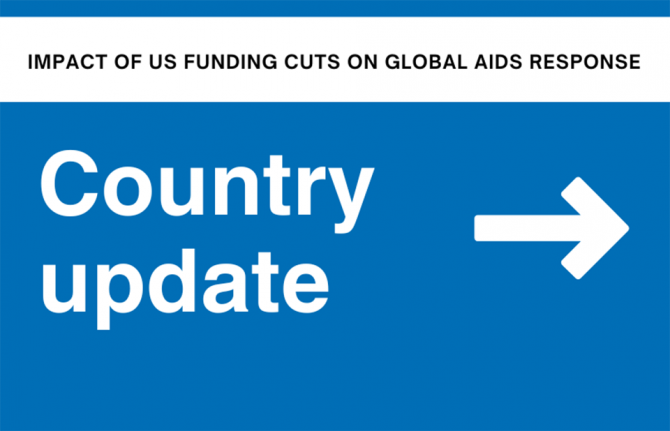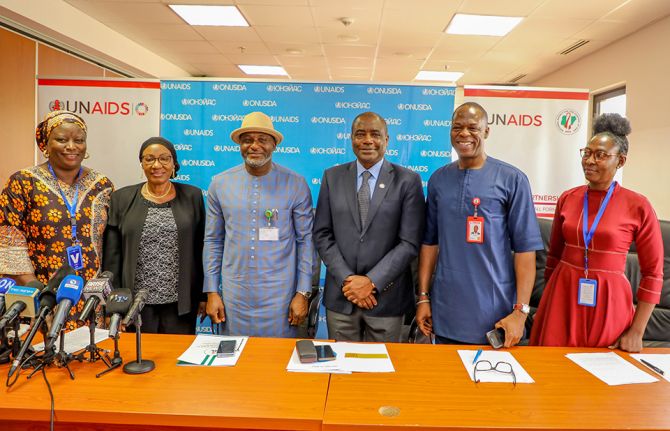
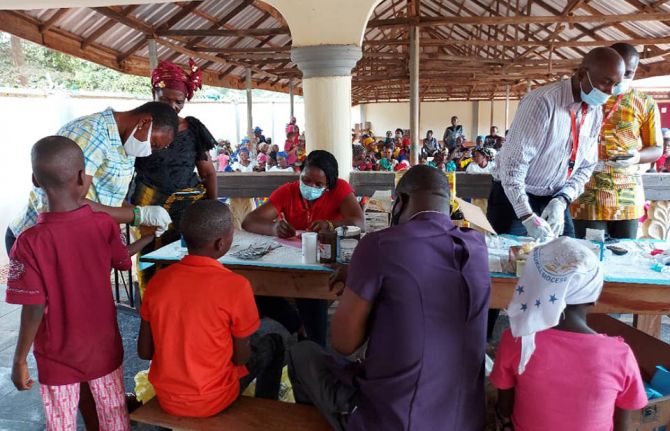
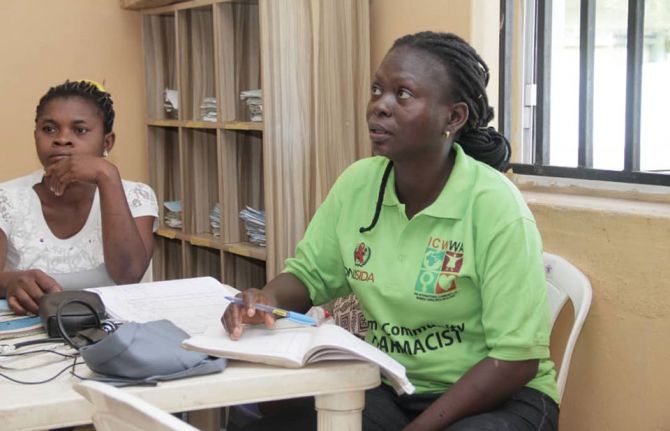
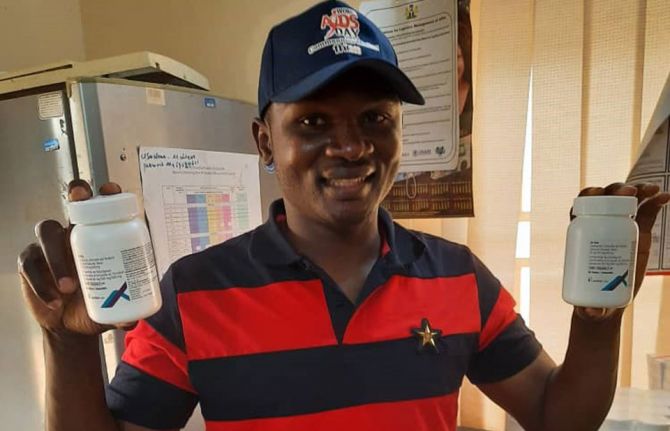
Feature Story
Putting people at the centre brings good results in Nigeria
05 March 2021
05 March 2021 05 March 2021Nigeria has demonstrated that putting people at the centre of the AIDS response works in advancing HIV service delivery. The 2018 Nigeria HIV/AIDS Indicator and Impact Survey identified 10 states with HIV prevalence above 2%, nine of which had a significant unmet need for HIV treatment and were at risk of being left behind if no action was taken. These states were prioritized by the national AIDS response for concerted action with the help of the United States President’s Emergency Plan for AIDS Relief (PEPFAR) and the Global Fund to Fight AIDS, Tuberculosis and Malaria (Global Fund).
In 2020, while many countries experienced HIV service disruptions, the PEPFAR-supported HIV programme in Nigeria experienced significant growth and exceeded some targets.
“The achievements of Nigeria with PEPFAR and the Global Fund in 2020 have significantly moved the needle towards treatment saturation and advanced the hope of epidemic control and the end of AIDS in these states and the entire country,” said Osagie Ehanire, the Minister of Health of Nigeria.
PEPFAR’s leadership and implementing partners took quick action and fast-tracked their community engagement plans, utilizing existing community network machinery to ensure there were no disruptions in the delivery of HIV services.
“Thanks to PEPFAR and its implementing partners, Nigeria was able to ensure not just continuity of HIV services, but was able to expand the reach, despite the country being locked down due to COVID-19,” said Gambo Aliyu, Director-General of the National AIDS Coordination Agency. “A record 279 000 people living with HIV additionally were put on treatment during this period.”
PEPFAR, together with its implementing partners, developed a people-centred package of services that was informed by data, best practices and community intelligence. The package recognized that one size does not fit all and catered for the unique needs of the various populations served.
Existing community networks, including key population networks and social groups, were consulted to determine the best way to make sure that the services that people need were available to them in their homes, at social gatherings or through support groups—thus minimizing contact with facilities.
Community antiretroviral therapy teams (CART teams) went to hard-to-reach areas around the country as well as to areas effected by COVID-19 lockdowns. Programmes such as a minimum three-month provision of antiretroviral therapy and viral load services were provided at treatment pick-up areas, which not only helped community-led providers to ensure that people stayed on treatment but saw a record number of people living with HIV start on treatment. By the end of 2020, the majority of people on treatment were included in the multimonth dispensing programme, which had a large impact on HIV treatment retention and adherence.
Viral load samples were collected in the communities, sent to laboratories for analysis and the results were then sent to health-care facilities, from where people were notified—this had a positive impact on viral load coverage. Index testing was expanded through community networks, ensuring continuity and safety as well as improvements in testing and case finding.
Results were seen across the entire 90–90–90 cascade as follows:
- An increase in people on HIV treatment of more than 279 000 people living with HIV in 2020, with more than 131 000 people being initiated and retained in care during the fourth quarter alone. PEPFAR Nigeria showed excellent success, accelerating efforts to identify people living with HIV and link them to care, with quarter-on-quarter growth. The growth in people on HIV treatment saw an additional seven states moving towards treatment saturation since the initiation of the “surge” programme approach, where intervention efforts are dramatically scaled up. Key populations represented approximately 25% of this overall growth, as the number of people on treatment among most key populations tripled. Key populations also had a testing yield of more than 10%.
- Improvements in pre-exposure prophylaxis (PrEP) uptake, especially among key populations. The number of people newly initiated on PrEP rose from nearly 2000 in the third quarter of 2020 to nearly 23 000 in the fourth quarter.
- Scale-up of multimonth dispensing from 55% in the first quarter to 94% in the fourth quarter 2020 was a key factor in improved continuity of treatment.
- Improvement in viral load coverage (88%) and suppression (93%) by the third quarter, building on previous successes and maintaining those gains to approach the third 90 target in a little over six quarters.
- PEPFAR’s orphans and vulnerable children programme achieved and exceeded all targets set for the year, including more than a million orphans and vulnerable children served by PEPFAR Nigeria by the end of 2020. Additionally, 98% of those under the age of 18 years in the orphans and vulnerable children programme have a documented HIV status, and approximately 100% of those who tested HIV-positive started treatment.
These results could not have been achieved without the support of community-led organizations. “The Network of People Living with HIV/AIDS in Nigeria (NEPWHAN) wishes to thank PEPFAR for the continuous engagement of our members across the country in the provision of HIV services to people living with HIV,” said Ibrahim Abdulkadir, NEPWHAN National Coordinator. “This has increased retention in care and improved quality of life for people living with HIV, as well as viral suppression among people living with HIV on antiretroviral therapy.”
PEPFAR Nigeria has designed its approach so that it can be owned by the Nigerian people. The National Data Repository and the National Alignment Strategy are key building blocks of a long-term and sustainable public health and health services approach to ending the AIDS epidemic in the country.
“I am profoundly impressed by the progress that PEPFAR Nigeria has made, in collaboration with the Government of Nigeria, partners and allies, to identify, enrol and sustain so many Nigerian people living with HIV on life-saving treatment,” said Bill Paul, the Deputy Coordinator for Program Quality, Office of the United States Global AIDS Coordinator. “Their success in sustaining the effort despite the impact of COVID-19 would not have been possible without a supportive policy environment both in the government and in the United States embassy.”
Based on these accomplishments, Nigeria is well-positioned to accomplish the 95–95–95 targets well in advance of 2030.
At the end of 2020, progress on the 90–90–90 treatment targets was 73–89–78—that is, 73% of people living with HIV had been diagnosed, 89% of those diagnosed were accessing treatment and 78% of those accessing treatment were virally supressed.
The proposed new global AIDS strategy calls for putting people at the centre of the HIV response, empowering communities and closing the gap on inequalities. “Nigeria is poised to be the next HIV turnaround country, after South Africa. We have all the ingredients to make this happen and I commend PEPFAR for working with the government, communities and partners to show the world that this is the only way to end this pandemic, by working with the affected communities,” said Erasmus Morah, the UNAIDS Country Director for Nigeria.

